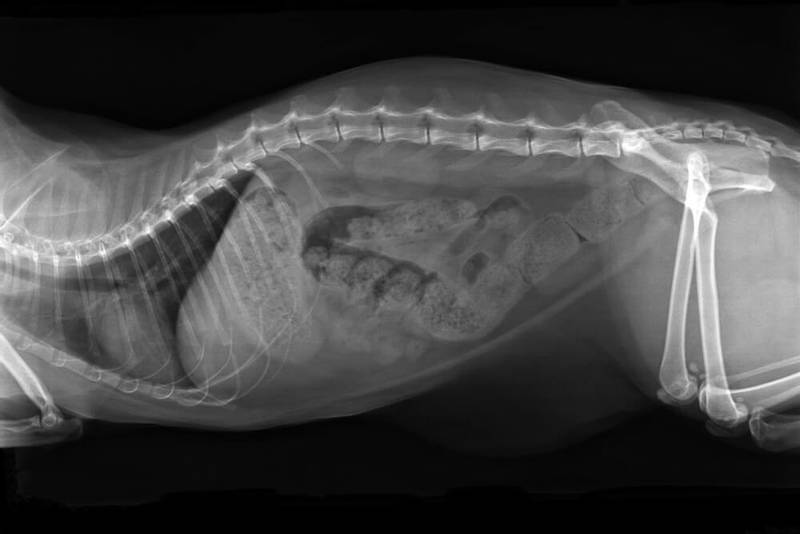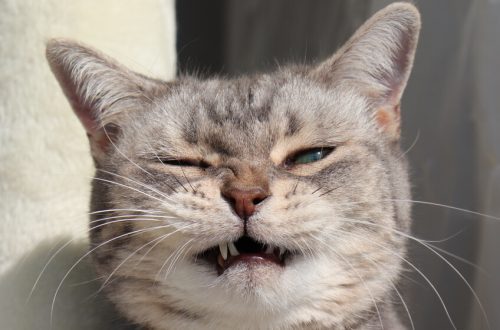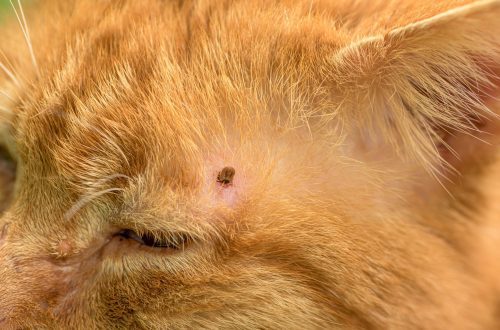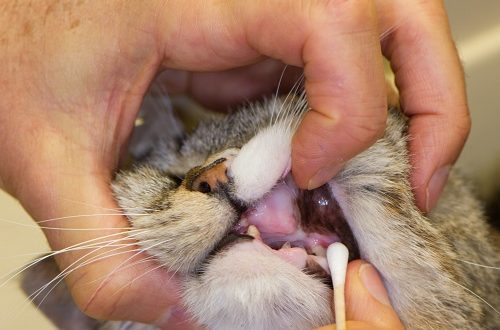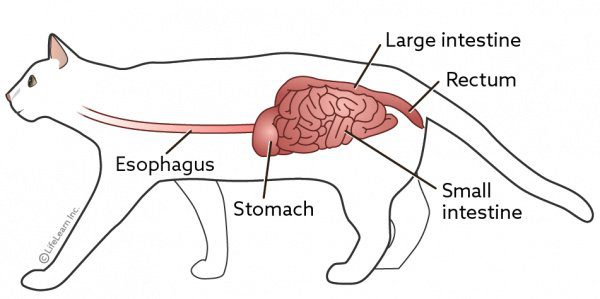
Constipation in a cat or a cat: what to do?
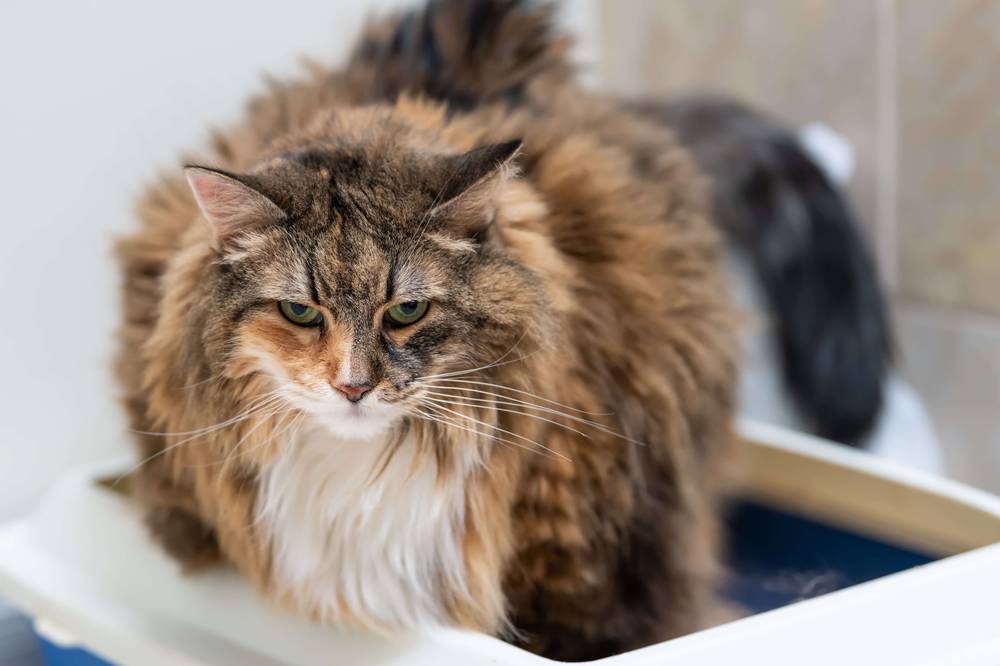
Contents
Constipation: basic information
It is possible to establish that a cat has constipation on its own at home, however, starting treatment without specifying the cause of this condition can be dangerous;
Constipation can occur in cats of any age, but older animals are more prone to chronic constipation;
The most common causes of constipation are dietary errors.
What is considered constipation?
Constipation (constipation) – irregular bowel movements, with increased intervals, feces are dry, dense. Chronic constipation and episodic constipation can be distinguished. Chronic can be called regular or recurrent episodes of difficult defecation. Episodic constipation is called if it happened once and did not recur after solving the problem. Chronic constipation is more prone to older animals with other chronic diseases. Episodic constipation can happen at any age.
Causes of constipation
Food
Nutrition plays an important role in regular bowel movements. Most often, problems arise with unbalanced natural feeding, the so-called “natural”. It is simply impossible to balance a natural diet for a cat on its own; nutrition must meet at least 56 points of various indicators: energy value, proteins, fats, carbohydrates, vitamins, minerals and amino acids. In order for the pet to have enough for a quality life, such a diet should be compiled by a nutritionist. Basically, constipation occurs when the diet is high in protein and low in fiber. But an unbalanced diet is especially dangerous for kittens. On such a diet, they are often diagnosed with alimentary hyperparathyroidism – this is a disease due to which calcium leaves the bone tissue into the blood, the bones become thin, brittle. The kitten has constant pain, he cannot take a position suitable for defecation.
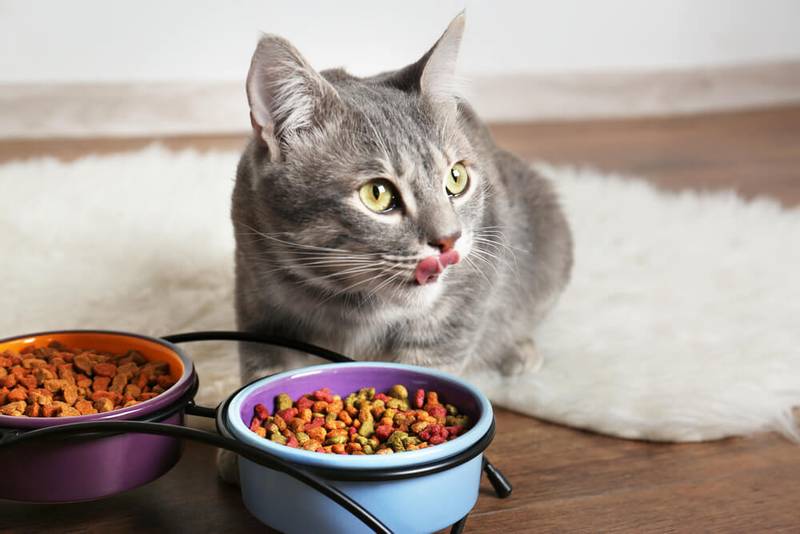
Constipation is also to be expected when fed dry industrial rations if the animal is drinking very little water. For the formation of feces of the correct consistency, there must be enough water in the intestines. If there is not enough water, the feces will turn out dry and hard at the exit, while the frequency of defecation will decrease, the animal will experience pain when going to the tray.
This should also include feeding foods that are not at all suitable for a cat (for example, bones). In general, the cat’s stomach is able to digest small bones, but there are many cases of surgical extraction of bones from the intestine. Bones can not only get stuck and cause constipation and obstruction, but also lead to perforation of the intestine, that is, simply tear it in some part.
Hairballs
Hairballs in the intestines can also lead to obstruction and constipation. Long-haired cat breeds are especially prone to this, as well as cats that are overly active in grooming themselves. Normally, wool should come out naturally, but if too much of it gets inside, it can cause various problems. Most often, large hairballs remain in the stomach, this can manifest itself as periodic vomiting without worsening overall well-being. But also the hair can go further down the intestines, and especially dense lumps can simply stop in the thin part of the intestine.
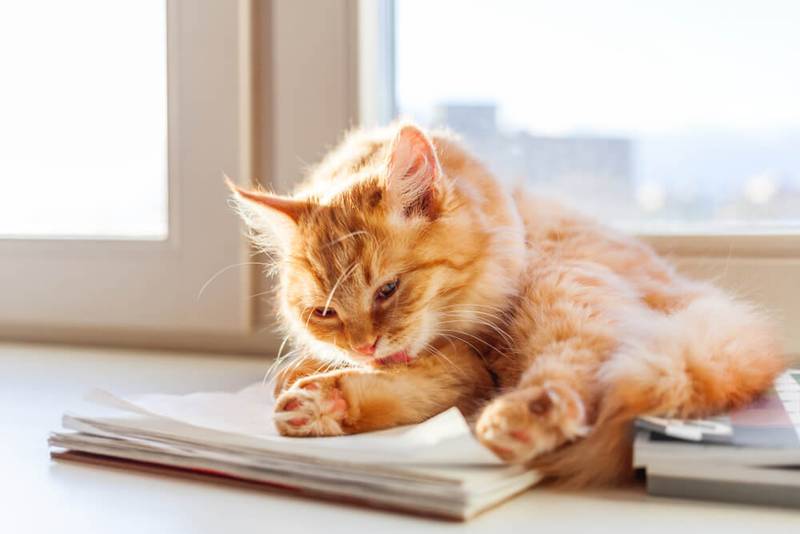
vermin
This cause of constipation is relatively rare. The main problem is that a large number of helminths can curl up and get stuck in the small intestine. Street animals and animals without regular treatment for parasites are prone to this. This condition can be extremely life-threatening. In addition to the fact that the cat is deprived of the opportunity to empty the intestines and experiences pain in the place of obstruction, a large number of helminths cause general intoxication of the body. It should also be borne in mind that if you give a cat a helminth drug on your own, this can lead to a deterioration in well-being due to the mass death of parasites, but will not solve the problem of constipation.
disease
A large number of different diseases can lead to the development of constipation in cats. These include the following:
Chronic renal failure
The appearance of constipation in kidney disease is mainly associated with general dehydration, that is, a decrease in the amount of fluid in the body. The animal itself is dehydrated – becomes dehydrated, dry and hard and feces. Of the additional symptoms in a cat, you can notice periodic vomiting, loss of appetite, weight loss, increased drowsiness.
Tumors
The presence of bulky tumors mechanically interferes with the movement of feces through the intestines. Tumors can be both in the intestinal lumen itself, that is, blocking the passage for fecal masses, like a cork, and in the area of other abdominal organs, while squeezing the intestines from the outside with their size. Vomiting will also be noted, it can be either rare, periodic, or repeated, incessant. The animal will feel pain of varying degrees of intensity, will be more lethargic, and appetite will decrease. Enlarged superficial lymph nodes may be palpable.
Neurological disorders
Various diseases in the area of the nervous system can lead to disruption of intestinal innervation, as a result of which peristalsis decreases or completely disappears, due to which the masses move through the intestines. Often this is associated with injuries in the lumbar spine, with fractures of the vertebrae, compression of the spinal cord and spinal nerve roots. The sensitivity of the pelvic limbs may be impaired or there may be no support on them at all.
Anatomical defects of the pelvic bones
Improper anatomical structure of the pelvis can also lead to constipation. This condition is congenital if the fetus was incorrectly formed in utero for some reason or has genetic abnormalities. It can also be the result of a fracture and improper fusion of the pelvic bones: for example, if the cat was hit by a car or fell from a height, and qualified assistance was not provided to him. The space between the bones of the pelvis, into which the rectum exits, is too narrow, and the feces simply do not pass into it.
Mechanical obstruction
Cats are big fans of eating inedible objects. Large dense objects, such as balls, mouse toys, quite often enter the cat’s stomach and then get stuck in the narrow part of the intestine. A mandatory symptom in this condition will be vomiting, most often repeated, especially after trying to eat or drink.
Orthopedic diseases
Various diseases of the musculoskeletal system (for example, arthritis, Scottish chondrodysplasia, etc.) lead to the inability to take a comfortable position due to pain. The cat has to endure the urge to defecate, as the desired position in the tray causes even more pain. It will be difficult for a pet to jump onto high surfaces, sometimes cats cannot even jump over the side of the tray.
Megacolon

This is a condition of a prolonged increase in the volume of the colon and a decrease in its peristalsis. It can be both congenital and occur due to already existing long-term constipation. Fecal masses in this condition accumulate for a long time in the intestinal lumen, dehydrate and thicken.
Atresia anus
A congenital anatomical defect, which consists in the absence of the anus and, accordingly, the impossibility of defecation. The large intestine ends blindly in the abdominal cavity, and the feces simply remain in it.
Constipation after sterilization
Sterilization can also cause constipation. The culprit may be drugs or painkillers. Also, a decrease in overall activity after surgery slows down the bowels. The absence of stools up to 3-4 days after sterilization is not something to worry about. However, there are also postoperative complications such as adhesions (this is a pathological proliferation of connective tissue between organs or in the walls of the organs themselves). They can interfere with the normal functioning of the intestine, squeeze it, and prevent it from contracting.
Symptoms of constipation in a cat or cat
Usually, owners can identify the symptoms of constipation in their cat or cat on their own. It is possible to note a more rare defecation (1 time in 2-3 days and longer) or a complete absence of defecation. The stool may be small, drier, in the form of a thin ribbon or hard lumps. The cat may show anxiety when trying to defecate, meow or even scream. At the same time, the cat will often and unsuccessfully run to the tray with constipation in much more rare cases than with acute urinary retention, the owners often confuse these conditions. Usually, the absence of bowel movements is noticed only by a clean tray. The complete absence of bowel movements may indicate intestinal obstruction, most often the cause is the eating of foreign bodies, vomiting will be an accompanying symptom.
Feces in the form of a thin ribbon may be a symptom of the presence of a large mass in the abdominal cavity or intestines. The complete absence of the urge to defecate or a rare involuntary defecation indicates a pathology in the region of the nerves that innervate the intestines. Prolonged absence of defecation and accumulation of feces in the intestines lead to intoxication of the body, vomiting, refusal to eat, and general depression may begin. The abdomen may become hard and painful to the touch. Without help, the animal will eventually die.
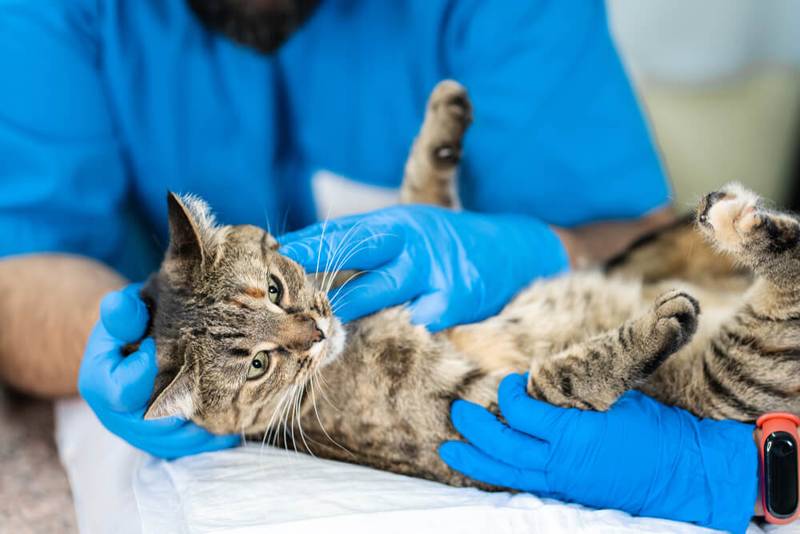
Diagnostics
Various methods are required to diagnose and establish an accurate diagnosis. First of all, the doctor will collect a detailed history of life: how old is the animal, a detailed diet, treatment for parasites, previous diseases, conditions of detention. Next, you will need an anamnesis of the disease: what exactly is bothering you, how long ago it happened, what the feces look like, are there any other complaints besides constipation. Then the doctor will examine the animal, palpate the abdomen, rectal examination.
Additional research may be required. An abdominal x-ray will show the amount of stool in the intestine, contrasting foreign objects (eg, undigested bones) or evidence of non-contrasting foreign bodies, masses, colonic enlargement. An x-ray of the pelvic area will show if there are any anatomical changes in the pelvic bones, improperly fused fractures. Also, a doctor may prescribe a study with the soldering of a radiopaque substance, it will show whether the intestinal patency is preserved. Ultrasound of the abdominal cavity will show the presence of neoplasms, inflammatory processes in the intestines, and will help to assess whether peristalsis is preserved in the intestines in various departments.
General clinical and biochemical blood tests can also help in making a diagnosis (for example, kidney disease). A stool test can show the presence of parasites. In rare cases, computed or magnetic resonance imaging, rectocolonoscopy may be indicated.
Treatment of constipation in cats
What to do if you are experiencing constipation in your cat or cat? First you need to contact the veterinary clinic and establish the exact cause, since self-treatment can be not only ineffective, but also dangerous. There are various drugs, nutritional supplements, and procedures that are used to treat it.
Laxatives:
Osmotic (lactulose, saline laxatives). Their principle of action is based on an increase in osmotic pressure in the intestinal lumen, due to which water rushes into it from the intercellular spaces and softens the feces;
Prokinetics (dommperidone, prucalopride, metoclopramide) are designed to stimulate intestinal motility and improve the movement of masses;
Emollients (vaseline oil) help soften feces, promote better gliding through the intestines.
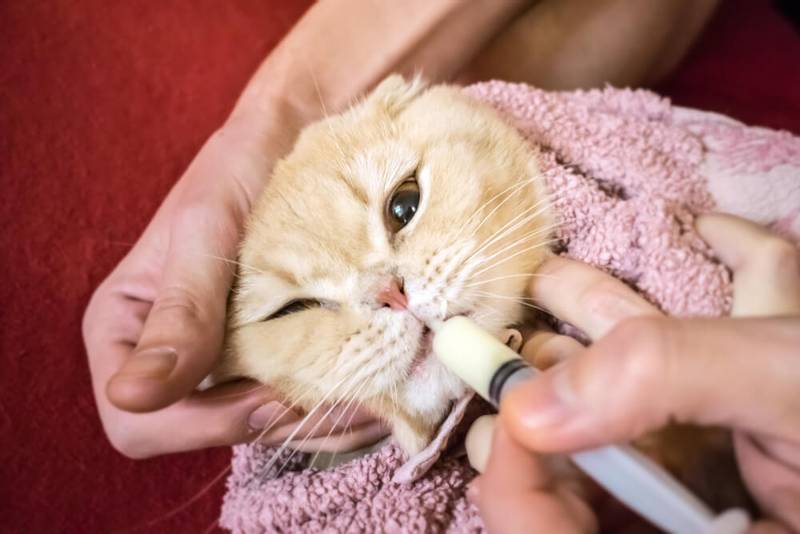
Feed and food additives
There is a line of special veterinary diets that are designed to treat chronic constipation in cats and cats. Foods that have worked well include Royal Canin Gastrointestinal Fiber Response and Hill’s Gastrointestinal Biome. These diets are high in fiber, which is necessary for better intestinal motility. Food supplements such as wheat bran and psyllium can also be used as an additional source of fiber.
Enema
It is not recommended to carry out such a serious procedure as a deep enema at home. Usually, a deep cleansing enema is prescribed in rather advanced cases, and manipulation is carried out only under anesthesia. In less severe cases of constipation in cats and especially small kittens, treatment with microenemas (Microlax) may be recommended by the doctor.
Operative intervention
In conditions such as the presence of a foreign body in the intestine, voluminous tumors, megacolon, anus atresia, treatment is possible only in the form of surgery. Independent use of laxatives, enemas and other methods can lead to very negative consequences, the main complication is intestinal rupture with the contents falling into the abdominal cavity, peritonitis and death.
Prevention
The main role in the prevention of constipation is played by a high-quality balanced diet. A nutritionist can help you choose the most appropriate individual diet option for preventing constipation in your cat or cat. Together with a nutritionist, you can discuss various options for industrial feed, create a natural diet or switch to a balanced mixed type of diet.
Also, fresh water should always be present in the cat’s diet. Often cats do not want to drink water on their own, then you have to resort to various tricks. By nature, cats prefer to drink only clean water, so if the bowl is next to a litter box or a bowl of food, often the cat may refuse to drink such water. Also in this regard, many cats prefer to drink only running water, a special drinking fountain is well suited for this. Some cats have individual preferences regarding the shape of the bowl from which they will drink: large, small, flat, deep.
Do not neglect the annual preventive examinations at the veterinary clinic, during which such diagnoses as diseases of the kidneys, joints, tumor processes and others can be established.
Preventive treatment for internal parasites should be carried out at least 2-4 times a year for a domestic cat. Also, do not forget about the annual complex vaccination.
The article is not a call to action!
For a more detailed study of the problem, we recommend contacting a specialist.
Ask the vet
December 17 2020
Updated: 21 May 2022



